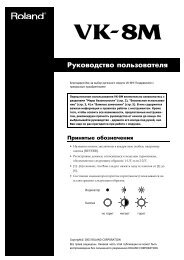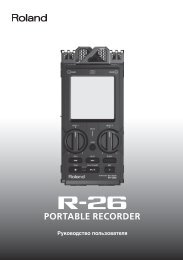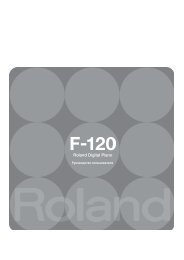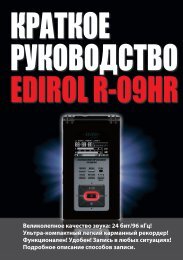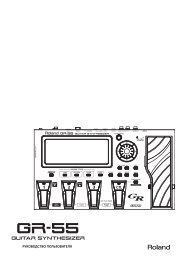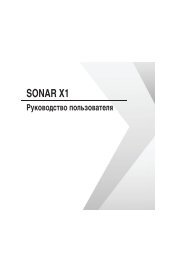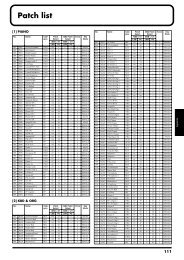Owner's Manual - Roland
Owner's Manual - Roland
Owner's Manual - Roland
- No tags were found...
Create successful ePaper yourself
Turn your PDF publications into a flip-book with our unique Google optimized e-Paper software.
MIDI Implementation■Example of an Exclusive Message andCalculating a Checksum<strong>Roland</strong> Exclusive messages (RQ1, DT1) are transmitted with a checksum at the end (beforeF7) to make sure that the message was correctly received. The value of the checksum isdetermined by the address and data (or size) of the transmitted Exclusive message.●How to calculate the checksum(hexadecimal numbers are indicated by “H”)The checksum is a value derived by adding the address, size, and checksum itself andinverting the lower 7 bits.Here’s an example of how the checksum is calculated. We will assume that in the Exclusivemessage we are transmitting, the address is aabbccddH and the data or size is eeffH.aa + bb + cc + dd + ee + ff = sumsum ÷ 128 = quotient ... remainder128 - remainder = checksum Setting CHORUS TYPE of PERFORMANCE COMMON toDELAY (DT1)According to the Parameter Address Map (P.311), the start address of TemporaryPerformance is 10 00 00 00H, the offset address of CHORUS at PERFORMANCE COMMONis 04 00H, and the address of CHORUS TYPE is 00 00H. Therefore the address of CHORUSTYPE of PERFORMANCE COMMON is;10 00 00 00H04 00H+) 00 00H10 00 04 00HDELAY has the value of 02H.So the system exclusive message should be sent is;F0 41 10 00 6B 12 10 00 04 00 02 ?? F7(1) (2) (3) (4) (5) address data checksum (6)(1) Exclusive Status (2) ID (<strong>Roland</strong>) (3) Device ID (17)(4) Model ID (Fantom-X6/X7/X8) (5) Command ID (DT1) (6) End of ExclusiveThen calculate the checksum.10H + 00H + 04H + 00H + 02H = 16 + 0 + 4 + 0 + 2 = 22 (sum)22 (sum) ÷ 128 = 0 (quotient) ... 22 (remainder)checksum = 128 - 22 (remainder) = 106 = 6AHThis means that F0 41 10 00 6B 12 10 00 04 00 02 6A F7 is the message should be sent.■The Scale Tune Feature (address: 40 1x 40)The scale tune feature allows you to finely adjust the individual pitch of the notes from Cthrough B. Though the settings are made while working with one octave, the fineadjustments will affect all octaves. By making the appropriate Scale Tune settings, you canobtain a complete variety of tuning methods other than equal temperament. As examples,three possible types of scale setting are explained below.* The scale tune value received by the part 1 is used in Patch mode and Piano mode.❍Equal TemperamentThis method of tuning divides the octave into 12 equal parts. It is currently the most widelyused form of tuning, especially in occidental music. On the Fantom, the default settings forthe Scale Tune feature produce equal temperament.❍Just Temperament (Tonic of C)The principal triads resound much more beautifully than with equal temperament, but thisbenefit can only be obtained in one key. If transposed, the chords tend to becomeambiguous. The example given involves settings for a key in which C is the keynote.❍Arabian ScaleBy altering the setting for Scale Tune, you can obtain a variety of other tunings suited forethnic music. For example, the settings introduced below will set the unit to use the ArabianScale.Example SettingsNote name Equal Temperament Just Temperament (Key-tone C) Arabian ScaleC 0 0 -6C# 0 -8 +45D 0 +4 -2Eb 0 +16 -12E 0 -14 -51F 0 -2 -8F# 0 -10 +43G 0 +2 -4G# 0 +14 +47A 0 -16 0Bb 0 +14 -10B 0 -12 -49The values in the table are given in cents. Convert these values to hexadecimal, and transmitthem as Exclusive data.For example, to set the tune (C-B) of the Part 1 Arabian Scale, send the following data:F0 41 10 42 12 40 11 40 3A 6D 3E 34 0D 38 6B 3C 6F 40 36 0F 76 F7■ASCII Code TablePatch Name and Performance Name, etc., of MIDI data are described the ASCIIcode in the table below.+——————+——————+——————++——————+——————+——————++——————+——————+——————+| D | H | Char || D | H | Char || D | H | Char |+——————+——————+——————++——————+——————+——————++——————+——————+——————+| 32 | 20H | SP || 64 | 40H | @ || 96 | 60H | ` || 33 | 21H | ! || 65 | 41H | A || 97 | 61H | a || 34 | 22H | " || 66 | 42H | B || 98 | 62H | b || 35 | 23H | # || 67 | 43H | C || 99 | 63H | c || 36 | 24H | $ || 68 | 44H | D || 100 | 64H | d || 37 | 25H | % || 69 | 45H | E || 101 | 65H | e || 38 | 26H | & || 70 | 46H | F || 102 | 66H | f || 39 | 27H | ` || 71 | 47H | G || 103 | 67H | g || 40 | 28H | ( || 72 | 48H | H || 104 | 68H | h || 41 | 29H | ) || 73 | 49H | I || 105 | 69H | i || 42 | 2AH | * || 74 | 4AH | J || 106 | 6AH | j || 43 | 2BH | + || 75 | 4BH | K || 107 | 6BH | k || 44 | 2CH | , || 76 | 4CH | L || 108 | 6CH | l || 45 | 2DH | — || 77 | 4DH | M || 109 | 6DH | m || 46 | 2EH | . || 78 | 4EH | N || 110 | 6EH | n || 47 | 2FH | / || 79 | 4FH | O || 111 | 6FH | o || 48 | 30H | 0 || 80 | 50H | P || 112 | 70H | p || 49 | 31H | 1 || 81 | 51H | Q || 113 | 71H | q || 50 | 32H | 2 || 82 | 52H | R || 114 | 72H | r || 51 | 33H | 3 || 83 | 53H | S || 115 | 73H | s || 52 | 34H | 4 || 84 | 54H | T || 116 | 74H | t || 53 | 35H | 5 || 85 | 55H | U || 117 | 75H | u || 54 | 36H | 6 || 86 | 56H | V || 118 | 76H | v || 55 | 37H | 7 || 87 | 57H | W || 119 | 77H | w || 56 | 38H | 8 || 88 | 58H | X || 120 | 78H | x || 57 | 39H | 9 || 89 | 59H | Y || 121 | 79H | y || 58 | 3AH | : || 90 | 5AH | Z || 122 | 7AH | z || 59 | 3BH | ; || 91 | 5BH | [ || 123 | 7BH | { || 60 | 3CH | < || 92 | 5CH | \ || 124 | 7CH | | || 61 | 3DH | = || 93 | 5DH | ] || 125 | 7DH | } || 62 | 3EH | > || 94 | 5EH | ^ ||——————+——————+——————+| 63 | 3FH | ? || 95 | 5FH | _ |+——————+——————+——————++——————+——————+——————+D: decimalH: hexadecimal* “SP” is space.329



